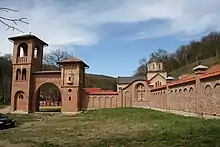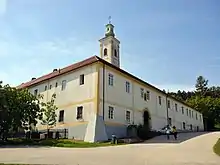Eparchy of Srem
The Eparchy of Srem (Serbian: Сремска епархија or Sremska eparhija) is an eparchy (diocese) of the Serbian Orthodox Church in the Syrmia (Srem) region, Serbia. Most of the eparchy is in the autonomous province of Vojvodina, and it also includes a small south-eastern part of Syrmia within the city limits of Belgrade, as well as some West Syrmian parishes in the border region of Croatia. The seat of the eparchy is at Sremski Karlovci. Since 1986, the diocesan bishop is Vasilije Vadić.[1]
Eparchy of Srem Епархија сремска | |
|---|---|
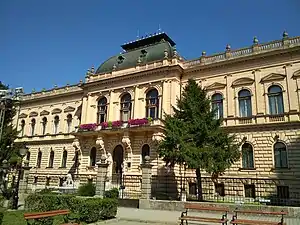 | |
| Location | |
| Territory | Syrmia in Serbia plus three parishes in Croatia |
| Headquarters | Sremski Karlovci, Sremski Karlovci |
| Information | |
| Denomination | Eastern Orthodox |
| Sui iuris church | Serbian Orthodox Church |
| Cathedral | St. Demetrius Cathedral, Sremski Karlovci |
| Language | Church Slavonic Serbian |
| Current leadership | |
| Bishop | Vasilije Vadić |
| Map | |
-en.svg.png.webp) | |
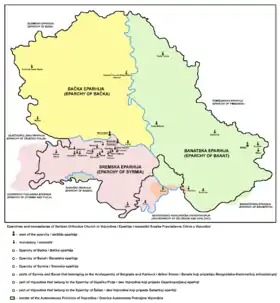
.png.webp)
History
The Eparchy of Srem is one of the oldest ecclesiastical institutions in this part of Southeastern Europe. The Bishopric of Sirmium was an important ecclesiastical center of the late Roman Empire in the 4th and 5th centuries. The bishopric collapsed after 582 when ancient Sirmium was finally destroyed by Avars.
After the Christianization of the Slavs, the eparchy was revived, and from 1018 it belonged to the Eastern Orthodox Archbishopric of Ohrid. During the late Middle Ages, the region of Srem came under the jurisdiction of the Serbian Metropolitans of Belgrade. The most notable of these was St Maksim Branković, metropolitan of Belgrade and Srem (died 1516) who built the Monastery of Krušedol.[2] During the 16th and 17th centuries they styled themselves as Metropolitans of Belgrade and Srem. In 1708, when the autonomous Serbian Metropolitanate was created within the Habsburg monarchy, the Eparchy of Srem became the archdiocese of the Metropolitan, whose seat was in Sremski Karlovci. The Eparchy remained part of the Metropolitanate of Karlovci until the end of the First World War.
In 1920, when all the Serbian ecclesiastical provinces united into one Serbian Orthodox Church, the Eparchy of Srem, with its seat at Sremski Karlovci, came under the administration of Archbishop of Belgrade, who was also the Serbian Patriarch. Final unification of two eparchies was completed in 1931 when the Eparchy of Srem and the Archbishopric of Belgrade were united as the Archbishopric of Belgrade and Karlovci. During that period, the diocesan administration was delegated to titular bishops as archdiocesan vicars.
In 1947, the region of Srem was excluded from the Archbishopric of Belgrade and Karlovci, and re-established as the separate Eparchy of Srem. Although the name of the Archbishopric of Belgrade and Karlovci still includes the name of the town of Sremski Karlovci, that town is today part of the Eparchy of Srem and not of the Archbishopric of Belgrade and Karlovci.
Seminary
The eparchy also possesses an Orthodox seminary at Sremski Karlovci. The seminary was founded in 1794. It is the second-oldest Orthodox seminary in the world (after the Spiritual Academy in Kyiv), and it operates to this day.
Monasteries belonging to the eparchy
| Name | First historical record |
Traditional founder | Traditional date of foundation |
|---|---|---|---|
| Beočin | 1566/7 | Unknown | |
| Bešenovo | 1545 | Serbian king Dragutin | End of the 13th century |
| Velika Remeta | 1562 | King Dragutin | |
| Vrdnik-Ravanica | The exact time of its founding is unknown. The records indicate that the church was built during the time of Metropolitan Serafim, in the second half of the 16th century. | ||
| Grgeteg | 1545/6 | Zmaj Ognjeni Vuk (despot Vuk Grgurević) | 1471 |
| Divša | Late 16th century | Despot Jovan Branković | Late 15th century |
| Jazak | 1736 | ||
| Krušedol | St Maksim Branković, Metropolitan of Belgrade and Srem, and his mother Saint Angelina of Serbia. | Between 1509 and 1516 | |
| Kuveždin | 1566-9 | Stefan Štiljanović | |
| Mala Remeta | Mid 16th century | Serbian king Dragutin | |
| Novo Hopovo | 1641 | The Despots of the Branković family. | |
| Privina Glava | 1566/7 | A man named Priva | 12th century |
| Petkovica | 1566/7 | The widow of Stefan Štiljanović, Despotess Jelena. | |
| Rakovac | 1545/6 | According to a legend recorded in 1704, Rakovac is the heritage of a certain man, Raka, courtier of despot Jovan Branković. | 1498 |
| Staro Hopovo | 1545/6 | Metropolitan Maksim Branković. | |
| Šišatovac | Mid 16th century | Refugee monks from the Serbian Monastery of Žiča. | |
| Fenek | 1563 | Stefan and Angelina Branković | Second half of the 15th century |
Bishops
Titular bishops - diocesan vicars:
- Maksimilijan Hajdin (1920—1928),
- Irinej Đorđević (1928—1931),
- Tihon Radovanović (1921—1934),
- Sava Trlajić (1934—1938),
- Valerijan Pribićević (1940—1941),
Bishops of Srem
- Vikentije Prodanov (1947—1951) (administrator)
- Nikanor Iličić (1951—1955)
- Makarije Đorđević (1955—1978)
- Andrej Frušić (1980—1986)
- Vasilije Vadić (since 1986)
See also
Gallery
Monasteries of Fruška Gora
Churches
 Sremski Karlovci Cathedral
Sremski Karlovci Cathedral Church in Sremska Mitrovica
Church in Sremska Mitrovica
 The temporary Orthodox church in Nova Pazova
The temporary Orthodox church in Nova Pazova Church in Ruma
Church in Ruma Church in Inđija
Church in Inđija Church in Šid
Church in Šid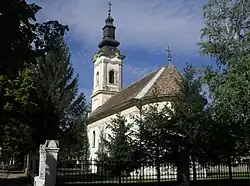 Church in Voganj
Church in Voganj
References
Sources
- Вуковић, Сава (1996). Српски јерарси од деветог до двадесетог века (Serbian Hierarchs from the 9th to the 20th Century). Евро, Унирекс, Каленић.
- Ćirković, Sima (2004). The Serbs. Malden: Blackwell Publishing. ISBN 9781405142915.
- Точанац, Исидора (2008). Српски народно-црквени сабори (1718-1735). Београд: Историјски институт САНУ. ISBN 9788677430689.
- Ingrao, Charles; Samardžić, Nikola; Pešalj, Jovan, eds. (2011). The Peace of Passarowitz, 1718. West Lafayette: Purdue University Press. ISBN 9781557535948.



